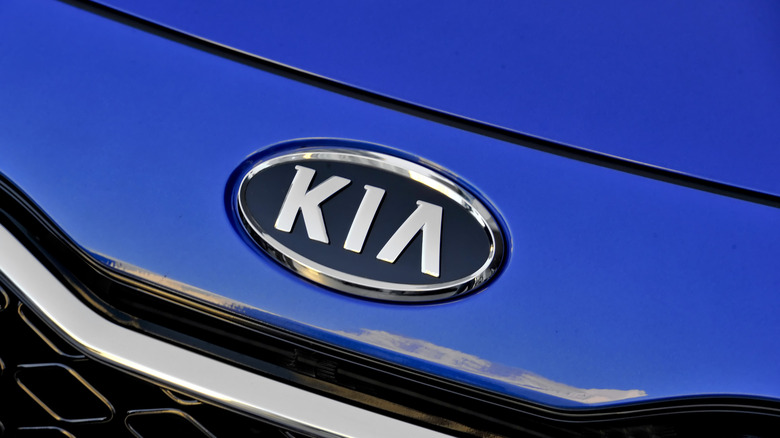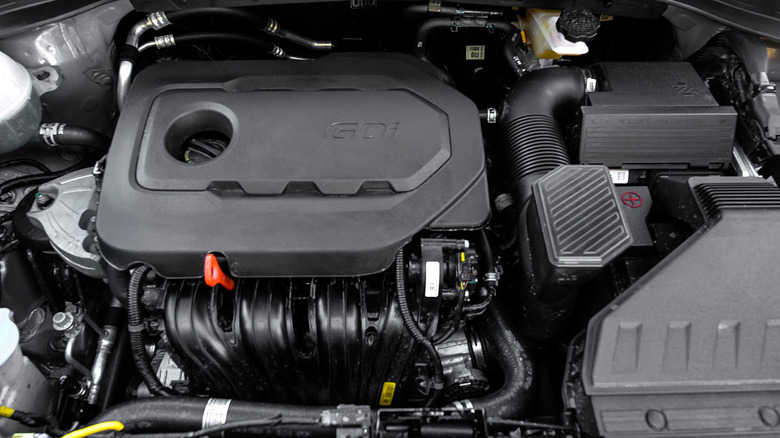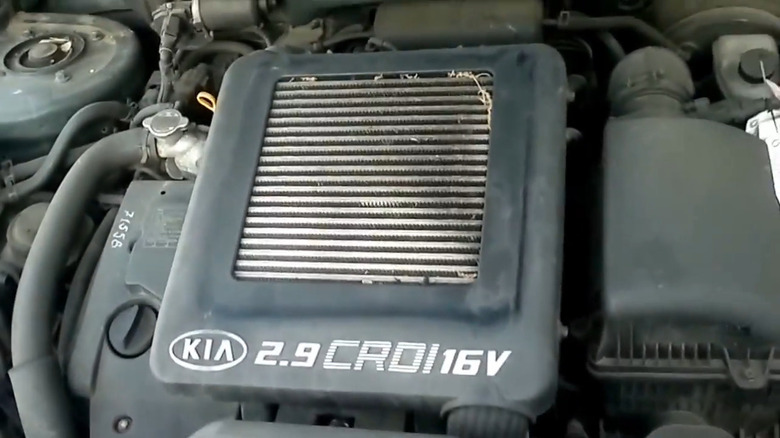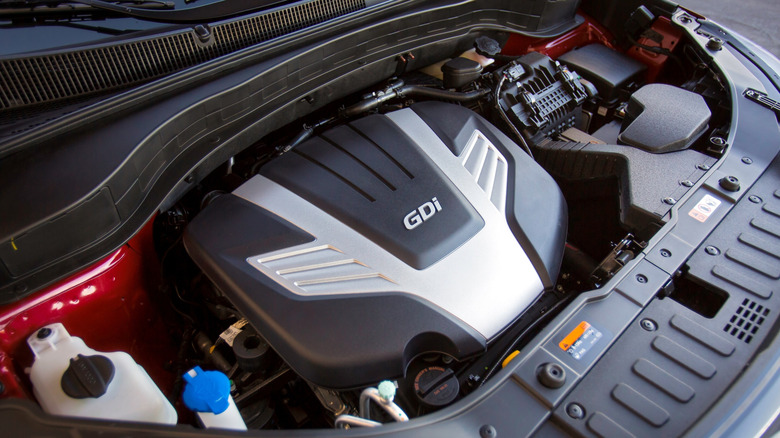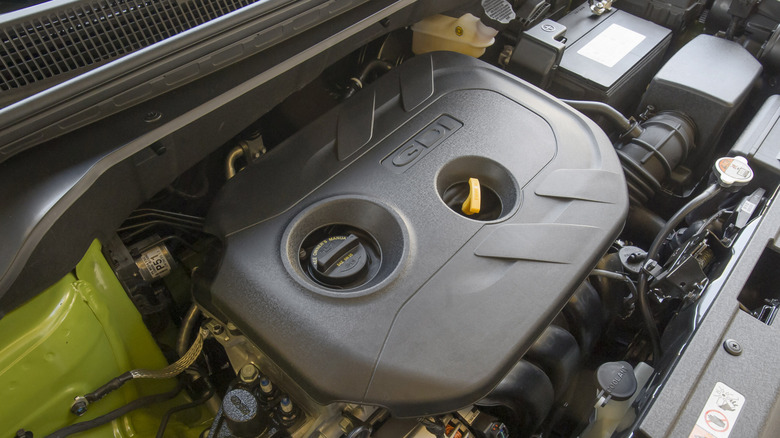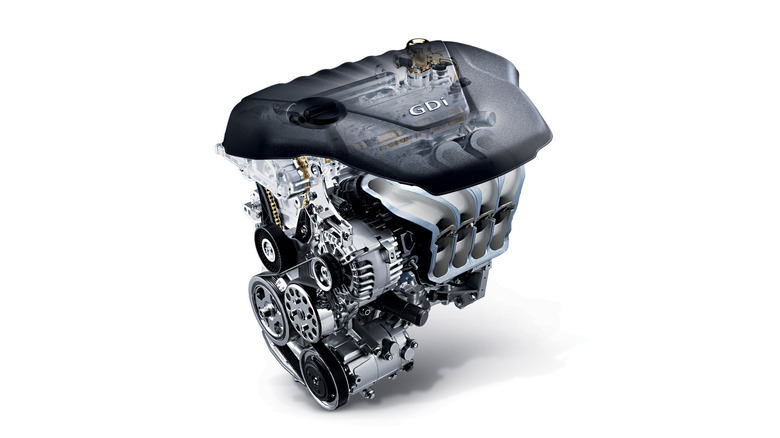5 Of The Worst Kia Engines Ever Made
Kia has come a long way from its humble beginnings in the 1970s. What was once a brand that licensed cars and motorcycles from Japanese brands, today pushes the boundaries on what's possible in an automobile together with its sister brand, Hyundai. Take the EV6 GT as an example; with 641 hp on tap and emulated internal combustion sounds, the aggressive-looking EV can put a huge smile on your face.
Kia also knows how to build powerful engines today. Remember the Stinger performance sedan? It had a 3.3-liter twin-turbo V6 with 368 hp and AWD, a combination that provided a 0-60 sprint below 5 seconds. Most of the brand's engines are rated well for reliability, too, with RepairPal rating Kia third out of all 32 car brands. Heck, we even built a list with the 10 most reliable Kia engines ever built, which further emphasizes the fact that Kia builds good engines.
However, not every Kia engine is a winner. In some cases, they've suffered catastrophic failures, recalls, and class-action lawsuits. Let's have a look at all of Kia's infamous engines and discuss their misfortunes.
Theta II 2.0-liter GDI / 2.4liter GDI (2011-2015)
The Hyundai/Kia Theta II family of engines is shows what can go wrong due to poor manufacturing. In particular, the 2.0-liter and 2.4-liter four-cylinder units produced in 2011 and 2012 were recalled because metal debris left from the manufacturing process gathered around the crankshaft, causing oil starvation.
Furthermore, the shavings mixed with the oil, causing poor lubrication to crucial parts, like the connecting rod bearings. This was a big problem for the Theta II engines, as it could cause a complete engine failure and even a fire. Fortunately, Kia found that the culprit was the deburring process that was used to remove the metal shavings. However, the misfortunes didn't stop there.
It was later found that models with direct injection (GDI) manufactured between 2011 and 2014 had an inherent issue, which starved crucial parts of the engine of oil, causing failures. And this would happen quite early, either during or shortly after the warranty period.
Unfortunately, Hyundai and Kia didn't respond quickly, although a Hyundai whistleblower leaked that the automakers knew about these issues. A class action lawsuit against Hyundai followed in 2016, and it took until 2017 for Kia to respond with an expanded recall. But the Kia/Hyundai Theta II engines suffer from myriad other problems, too. The GDI system led to increased carbon buildup and oil sludge deposits. Noisy operation and vibrations are also common. Unsurprisingly, the average life of Theta II engines is only around 150,000 miles.
J3 2.9-liter CRDi Diesel (2001-2009)
The Hyundai/Kia J family of four-cylinder diesel engines has been moving minivans and SUVs since 1992. However, most of these models have sold in overseas markets, with the first-gen J1 not even available in Europe. The second-gen J2 became more widespread, but it was largely based on the existing Mazda R2 engine.The third-gen J3 engine, though, was designed and produced by Kia and later adopted in Hyundai models.
Initially, Kia used a distributor pump on the J3 until 2001, when it was changed to common rail for higher efficiency and power. The most potent unit produced 185 hp and 258 lb-ft of torque — not bad for an early 2000s 2.9-liter turbodiesel. Unfortunately, the move to common rail in the first- and -second-gen Kia Carnival and first-gen Hyundai Terracan proved catastrophic.
Kia used Delphi's common rail high-pressure pumps and fuel delivery systems, which had a tendency to clog the injectors, stalling the engine. This happened mostly with low-quality diesel fuel; the Delphi equipment required clean, high-quality fuel and proper maintenance to operate normally. In fact, due to these issues, owners of these engines often revert back to Bosch's VE4 distributor pump. This solves the issue, but of course, makes the engine less powerful and efficient.
The J3 also suffers from electrical issues, coolant leaks, and oil starvation because of worn-down oil pump. Other than that, though, it's a sturdy unit that should last around 250,000 miles before a rebuild is necessary. Unfortunately, most owners found this out the hard way — replacing injectors and common-rail equipment is very expensive.
Lambda II 3.3-liter V6 GDI (2014 to Present)
The Theta II family isn't the only one facing scrutiny from regulatory bodies. The National Highway Traffic Safety Administration's (NHTSA) Office of Defects Investigation received a petition last year to investigate the 3.3-liter V6 Lambda II engine for knocking issues.
The Lambda V6 powered many Hyundai and Kia models and initially came with multi-point injection (MPI). However, the direct injection (GDI) models launched in 2011 are under investigation. The owner of a 2017 Hyundai Santa Fe reported knocking that lead to catastrophic engine failure and expensive repairs. In her letter to the NHTSA, the owner complained that the engine failed at 61,413 miles, requiring a full replacement costing $19,997 without labor costs. While this is an isolated incident, there's also a class action lawsuit in Canada covering most Hyundai/Kia GDI engines, including the 3.3-liter Lambda II.
The knocking also makes sense, because the GDI Lambda II V6 has been known for its extensive carbon buildup issues. This starves the combustion chamber for air, which then causes an incorrect air/fuel mixture and ultimately, knocking. If you have this, or another direct injection engine, here is how to prevent and clean carbon buildup. In addition, the direct injection Lambda II V6 is also infamous for its high oil consumption. Overall, the average lifespan of this engine is around 150,000 miles, which isn't a particularly good figure. Interestingly, the turbocharged 3.3-liter T-GDI, found inside the Stinger, has been reliable so far, despite producing significantly more power.
Nu 1.8-liter / 2.0-liter GDI (2013 to Present)
The Nu engine family has been launched in 2011, consisting of 1.8-liter and 2.0-liter four-cylinder units. Initially, these engines were equipped with multi-point port injection (MPI) but were later converted to direct injection (GDI). And again, it's the GDI units that are problematic, with similar issues as the Theta II family. Still, it's fair to say that, overall, the Nu GDI engines are more reliable than the Theta range.
The Nu engines often suffer from a faulty connecting rod bearing, which could lead to other issues, including a full engine failure. In some rare instances, the connecting rod could detach and puncture the engine block, leading to oil leaks and eventually fires. In fact, there were 60 instances of Hyundai and Kia vehicle fires due to issues with the Theta II, Nu GDI, and Gamma GDI engines.
Nu GDI engines also suffered from other issues. Like other Kia/Hyundai GDI engines, carbon buildup and oil consumption are common. The former is a common occurrence in all direct injection engines. Meanwhile, oil consumption is common on Kia Soul and Seltos produced between 2021 and 2023 due to defective oil piston rings.
Another well-documented problem with the Nu GDI engines is piston slap. This happens mostly when the engine is cold, and the parts are contracted, which causes high clearance between the piston and cylinder. Piston slap causes a ticking sound at idle can prematurely wear the piston rings and cause damage to the cylinder walls, which could then lead to increased oil consumption and decreased performance.
Gamma 1.6-liter GDI (2008 to Present)
Our last entry is another of Hyundai's & Kia's direct injection engines (noticing a pattern?). This one hasn't earned the same notoriety as its siblings, but we wouldn't call it reliable. The Gamma 1.6 GDI has a lifespan of no more than 150,000 miles and suffers from potentially problematic issues, like a failed cylinder head valve cover gasket, which leads to oil leaks.
The Gamma family is also under audit by the NHTSA for fire risks, so it could have the same issues as the Theta II and Nu engine families. Unsurprisingly, due to the direct injection feature, this engine suffers from carbon buildup, which could lead to power loss. Strange noises coming from the 1.6-liter GDI engine are also not uncommon.
Hyundai and Kia first introduced the Gamma 1.6-liter MPI engine in 2007, with the GDI variant following in 2008. Kia still uses the basic design to this day and offers the small four-cylinder engine in the K4 in overseas markets. Meanwhile, Kia offers the turbocharged T-GDI variant in global Sportage SUVs as part of the Gamma II family.
